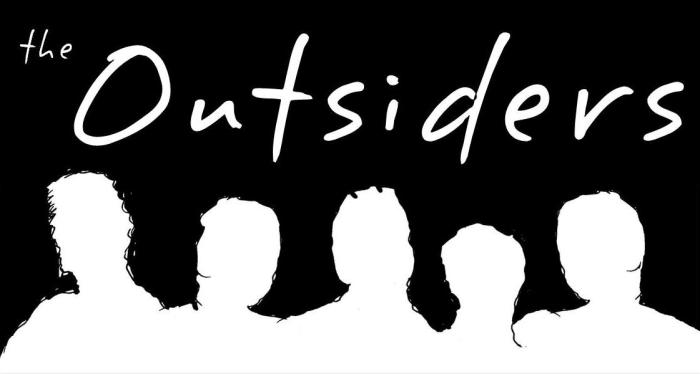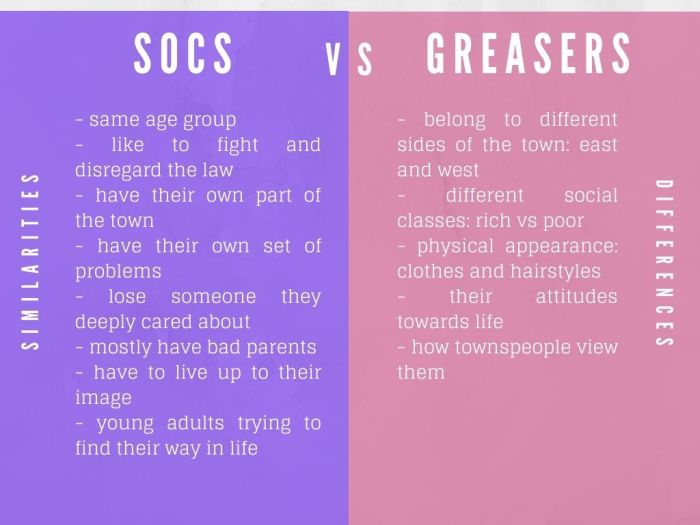Are you a greaser or a soc – Welcome to the world of “The Outsiders,” where the rivalry between Socs and Greasers defines the social landscape. In this captivating exploration, we delve into the defining characteristics, cultural expressions, and societal impact of these iconic groups, unraveling the complexities of their conflict and its enduring legacy.
From the affluent Socs to the rebellious Greasers, we’ll examine their distinct values, beliefs, and lifestyles, exploring the historical and social factors that fueled their rivalry. Along the way, we’ll encounter unforgettable characters, witness pivotal events, and gain a deeper understanding of the cultural divide that shaped their world.
Soc vs. Greaser



Socs and Greasers were two rival gangs in the 1960s, each with distinct characteristics and values.
Defining Characteristics
Socs (short for “Socials”) were typically from wealthy families and attended private schools. They valued social status, material possessions, and conformity. They dressed in preppy clothing, such as button-down shirts, khakis, and loafers. Their activities included attending parties, playing sports, and driving expensive cars.Greasers
were typically from working-class families and attended public schools. They valued loyalty, toughness, and individuality. They dressed in leather jackets, jeans, and T-shirts. Their activities included hanging out at drive-in restaurants, listening to rock ‘n’ roll music, and drag racing.Comparative
Table| Feature | Socs | Greasers ||—|—|—|| Socioeconomic status | Wealthy | Working-class || Family background | Private schools | Public schools || Values | Social status, conformity | Loyalty, toughness, individuality || Appearance | Preppy clothing | Leather jackets, jeans, T-shirts || Activities | Parties, sports, driving expensive cars | Drive-in restaurants, rock ‘n’ roll music, drag racing |
Soc vs. Greaser



The rivalry between Socs and Greasers in S.E. Hinton’s “The Outsiders” is a complex and multifaceted phenomenon that reflects the social and economic tensions of the time period. Socs, short for Socials, represent the wealthy and privileged upper class, while Greasers, also known as “grease monkeys,” represent the working-class youth.
Historical and Social Context
The post-World War II era in the United States was a time of significant economic growth and prosperity, but it also saw a widening gap between the rich and the poor. This disparity led to increased social tensions and resentment, particularly among the working class.
The Greasers, as members of the working class, felt marginalized and disenfranchised by the wealth and privilege of the Socs.
Whether you’re a greaser or a soc, there’s something about the Shirelles’ “Blank La La” that just resonates. This classic tune captures the innocence and longing of young love, reminding us that no matter what side of the tracks we’re on, we all have a heart that yearns for connection.
Class Differences and Social Tensions
The rivalry between Socs and Greasers was largely driven by class differences. The Socs, with their access to wealth and resources, often looked down upon the Greasers, who were seen as lower class and less educated. This condescension fueled resentment and hostility among the Greasers, who felt that the Socs were unfairly judging them based on their socioeconomic status.
Personal Grievances
In addition to class differences, personal grievances also contributed to the rivalry between Socs and Greasers. For example, in the novel, Bob, a Soc, kills Johnny, a Greaser, in a fight. This act of violence escalates the conflict between the two groups and leads to a cycle of retaliation and violence.
Soc vs. Greaser: Cultural Expression

Soc Cultural Expression
Socs, the privileged and wealthy upper-class teenagers, had their own unique cultural expressions. Their music was typically upbeat and cheerful, with popular genres including rock and roll, doo-wop, and pop. They favored preppy and sophisticated fashion, often wearing button-down shirts, khakis, and loafers.
Their social gatherings revolved around exclusive parties, dances, and country club events.
Greaser Cultural Expression
In contrast, Greasers, the working-class and rebellious teenagers, had a distinct cultural expression. Their music was often slower and more soulful, with a focus on rockabilly, rhythm and blues, and early rock and roll. They adopted a rebellious and edgy fashion, characterized by leather jackets, jeans, and slicked-back hair.
Their social gatherings typically involved drive-ins, malt shops, and street corners.
Cultural Values and Beliefs
The cultural expressions of Socs and Greasers reflected their underlying values and beliefs. Socs valued conformity, tradition, and social status, while Greasers embraced individuality, rebellion, and a sense of community. These differences in cultural expression contributed to the ongoing tension and rivalry between the two groups.
Soc vs. Greaser



In terms of gender roles and relationships, Socs and Greasers had contrasting expectations and attitudes.
Gender Roles and Expectations
Soc Society
- Traditional gender roles were prevalent, with men expected to be the breadwinners and protectors, while women were primarily responsible for domestic duties and child-rearing.
- Men were often seen as superior to women and held positions of power and influence.
- Women were expected to be submissive, demure, and focused on their appearance.
Greaser Society
- Gender roles were more fluid and egalitarian.
- Both men and women could work outside the home and contribute financially to the household.
- Women were respected for their strength and independence, and they often had a say in decision-making.
Attitudes towards Relationships, Dating, and Marriage, Are you a greaser or a soc
Soc Culture
- Dating was seen as a serious and formal process, often leading to marriage.
- Premarital sex was generally frowned upon, and relationships were expected to be monogamous.
- Marriage was considered a sacred institution, and divorce was rare.
Greaser Culture
- Dating was more casual and less structured.
- Premarital sex was more common, and relationships were often more open and less exclusive.
- Marriage was not as highly valued, and divorce was more common.
Soc vs. Greaser: Societal Impact: Are You A Greaser Or A Soc

The rivalry between the Socs and Greasers had a profound impact on the wider community, shaping social norms, values, and perceptions. The two groups’ distinct lifestyles and ideologies created a divide within the city, leading to increased tensions and conflicts.
Consequences for Individuals, Families, and the City
The rivalry had severe consequences for individuals, families, and the city as a whole. The constant clashes between the two groups resulted in violence, injuries, and even deaths. This climate of fear and uncertainty made it difficult for residents to live their lives peacefully.
Families were torn apart as members sided with different groups, and the city’s reputation suffered as it became known for its gang violence.
Top FAQs
What is the main difference between Socs and Greasers?
Socs represent the wealthy and privileged upper class, while Greasers are from a lower socioeconomic background and often face social marginalization.
What sparked the rivalry between Socs and Greasers?
The rivalry stems from a combination of class differences, social tensions, and personal grievances, often exacerbated by historical and societal factors.
How did Socs and Greasers express their cultural identities?
Socs embrace preppy fashion, attend social gatherings, and enjoy mainstream music, while Greasers adopt a rebellious style, frequent drive-in theaters, and listen to rock and roll.